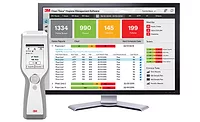Sponsored Content
University Study Findings Indicate Why Your ATP Test May Not Be Working

ATP hygiene monitoring tests are one of the most commonly used methods to verify cleaning effectiveness. This is because they are simple, easy-to-use, and provide immediate results. The principle of the test takes advantage of the assumption that changes in ATP are proportional to the degree of residual contamination remaining on food processing surfaces or equipment. If cleaning is ineffective, ATP-containing organic debris from food can be detected on both food processing surfaces or equipment. ATP tests are used by food processors in nearly every processing category, and experts estimate that more than 50 million tests are conducted every year worldwide.
Principle of ATP Testing
The mechanism of action of ATP tests involves the reaction of ATP with firefly luciferin—a light-emitting compound found in fireflies. The amount of light produced is proportional to the amount of ATP in a sample and is measured in relative light units (RLU) using a luminometer.
ATP hygiene monitoring tests depend on surface contaminants containing ATP in concentrations sufficient for detection. New research, however, shows that ATP levels fluctuate in various organic or biological soils independently of the actual soil level.
University of Wisconsin – Madison Study
Research recently published in the Journal of Food Protection,[1] has uncovered interesting data about changes in ATP concentrations in foods that may call into question the effectiveness of traditional ATP tests.
 In this study, researchers from the University of Wisconsin – Madison examined the levels of residual ATP from different types of raw meat (beef, pork, and chicken). The data showed that the concentration of ATP degraded in the raw meat samples over time, reducing the concentration of ATP present and therefore reducing the signal available to a test that detects only ATP. The study provided quantitative data of this shift in concentration from ATP to a state where immediate degradation products—ADP and AMP—become the predominant adenylate species present. This shift was shown to occur within a relatively short time frame—with ATP concentrations significantly reduced within a time frame that would correspond to only one or two production shifts.
In this study, researchers from the University of Wisconsin – Madison examined the levels of residual ATP from different types of raw meat (beef, pork, and chicken). The data showed that the concentration of ATP degraded in the raw meat samples over time, reducing the concentration of ATP present and therefore reducing the signal available to a test that detects only ATP. The study provided quantitative data of this shift in concentration from ATP to a state where immediate degradation products—ADP and AMP—become the predominant adenylate species present. This shift was shown to occur within a relatively short time frame—with ATP concentrations significantly reduced within a time frame that would correspond to only one or two production shifts.
.png) The study also showed that the total concentration of ATP plus these degradation products (ATP+ADP+AMP) was shown to remain relatively stable in the raw beef, pork, and chicken samples (Figure 1). Under these conditions, a test that detects only ATP, but not ADP or AMP, will consequently lose sensitivity as an effective indicator of the presence of residual soil. These findings agree with another previously published study[2] in the Journal of Food Protection that suggested that a test that detects ATP plus the degradation products of ATP will be able to detect raw meat residue much more effectively than a test that detects ATP alone.
The study also showed that the total concentration of ATP plus these degradation products (ATP+ADP+AMP) was shown to remain relatively stable in the raw beef, pork, and chicken samples (Figure 1). Under these conditions, a test that detects only ATP, but not ADP or AMP, will consequently lose sensitivity as an effective indicator of the presence of residual soil. These findings agree with another previously published study[2] in the Journal of Food Protection that suggested that a test that detects ATP plus the degradation products of ATP will be able to detect raw meat residue much more effectively than a test that detects ATP alone.
Kikkoman A3 Technology – An Advance in Test Chemistry
Because a test that can detect all three adenylates (ATP+ADP+AMP) will be more effective than one that detects ATP alone, Kikkoman developed “A3 Technology.” Kikkoman’s A3 Technology that employs two separate enzyme reactions for a unique change in the biochemistry of the assay. With the use of two enzymatic reactions, AMP and ADP can both be recycled back into ATP. This process allows the resulting test to detect the total adenylate concentration and dramatically increase the signal available to the test.
.png) The effect of this advanced technology can be seen in the comparison of test data from many common foods. In addition to the effect described by the University of Wisconsin – Madison, other factors, including processing methods, fermentation, curing, and others, can cause ATP to degrade in many foods to very low levels, making residues from these foods difficult or impossible to detect using a traditional ATP test. Because of the relatively stable concentration of total adenylates, however, the Kikkoman A3 test is able to detect residuals from these foods due to the higher levels of signal available, making the test a better indicator of cleaning efficiency.
The effect of this advanced technology can be seen in the comparison of test data from many common foods. In addition to the effect described by the University of Wisconsin – Madison, other factors, including processing methods, fermentation, curing, and others, can cause ATP to degrade in many foods to very low levels, making residues from these foods difficult or impossible to detect using a traditional ATP test. Because of the relatively stable concentration of total adenylates, however, the Kikkoman A3 test is able to detect residuals from these foods due to the higher levels of signal available, making the test a better indicator of cleaning efficiency.
Looking for quick answers on food safety topics?
Try Ask FSM, our new smart AI search tool.
Ask FSM →
Conclusion
?When considering the use of an ATP-based hygiene test, food processors should consider that variables such as time prior to cleaning, time between cleaning and verification, the source of the residual contamination, and physical conditions such as temperature may alter the quantity of ATP available, potentially making traditional ATP tests less effective.
Kikkoman’s A3 technology detects ATP+ADP+AMP and has been proven to detect residues that ATP tests miss. And because the difference is in the chemistry of the test, Kikkoman A3 tests are used in the same way as a conventional ATP test: Just swab sample sites in the same way you always have, and you may find what you have been missing.
Kikkoman Biochemifa Company is a subsidiary company of Kikkoman Corporation and a worldwide leader in ATP technology and innovative biochemistry.
References
- Smith N. W. et al. Quantities of adenylate homologues (ATP+ADP+AMP) change over time in Prokaryotic and Eukaryotic cells. J. Food Prot. 2019, 82, 2088.
- Bakke M. and Suzuki S. Development of a novel hygiene monitoring system based on the detection of total adenylate (ATP+ADP+AMP). J. Food Prot. 2018, 81, 729.






